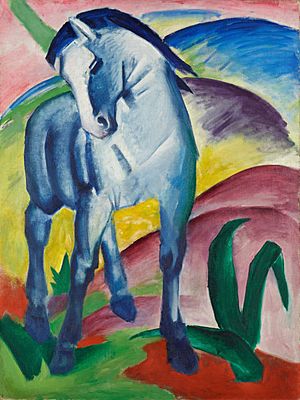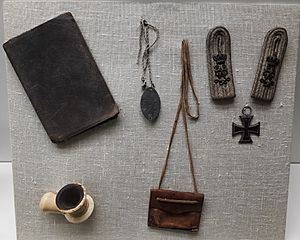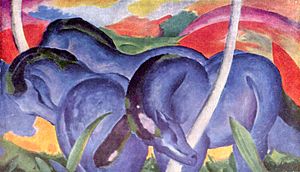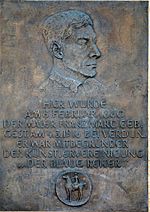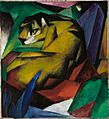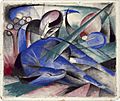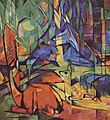Franz Marc facts for kids
Quick facts for kids
Franz Marc
|
|
|---|---|

Franz Marc in 1910
|
|
| Born | 8 February 1880 Munich, Bavaria, German Empire
|
| Died | 4 March 1916 (aged 36), while battling in World War 1 Braquis, France
|
| Nationality | German |
| Education | Academy of Fine Arts, Munich |
| Known for | Painting |
|
Notable work
|
paintings: Fate of the Animals, The Tower of Blue Horses, The Yellow Cow, Blue Horses, journal: Der Blaue Reiter |
| Movement | Expressionism |
Franz Marc (born February 8, 1880 – died March 4, 1916) was a German painter. He was also a printmaker, which means he made art using printing techniques. Franz Marc was one of the most important artists in a style called Expressionism. He helped start a famous art group and magazine called Der Blaue Reiter (The Blue Rider). This group's name became well-known for the artists who worked together in it.
Most of Franz Marc's later paintings show animals. These artworks are famous for their bright and strong colors. Marc joined the German Army when World War I began. He sadly died two years later during a big battle called the Battle of Verdun.
In the 1930s, a group called the Nazis called him a "degenerate artist". They tried to stop modern art from being shown. But most of Franz Marc's art survived World War II. This helped keep his artistic legacy alive. Today, his paintings are shown in many important art galleries and museums. When his major paintings are sold, they can go for a lot of money. One of his paintings, Weidende Pferde III (Grazing Horses III), sold for over £12 million.
| Top - 0-9 A B C D E F G H I J K L M N O P Q R S T U V W X Y Z |
Franz Marc's Early Life and Studies
Franz Marc was born in 1880 in Munich, Germany. At that time, Munich was the capital of a place called the Kingdom of Bavaria. His father, Wilhelm Marc, was a professional landscape painter. His mother, Sophie, took care of their home and was a very religious person.
When Marc was 17, he wanted to study theology, which is the study of religious beliefs. His older brother, Paul, was already studying it. But two years later, Franz decided to study art at Munich University. First, he had to serve in the military for a year. After that, in 1900, he started studying at the Academy of Fine Arts, Munich. There, he learned from teachers like Gabriel von Hackl and Wilhelm von Diez.
In 1903 and 1907, he spent time in France, especially in Paris. He visited the city's museums and copied many paintings. This was a common way for artists to learn and improve their skills. In Paris, Marc met many artists and even the famous actress Sarah Bernhardt. He really liked the paintings of Vincent van Gogh. After his trip in 1903, he stopped going to the Academy of Fine Arts.
During his twenties, Marc had some complicated personal relationships. He married twice. Both of his wives, Marie Schnür and Maria Franck, were also artists.
His Artistic Journey
In 1906, Marc traveled with his older brother Paul to Thessaloniki and other places in Greece. Paul was an expert on the Byzantine Empire. A few years later, in 1910, Marc became good friends with another artist named August Macke. In 1910, Marc painted Nude with Cat and Grazing Horses. He also showed his art in an exhibition for a group called the Neue Künstlervereinigung (New Artists' Association) in Munich. Marc was a member of this group for a short time.
The Blue Rider Art Group
In 1911, Marc started the Der Blaue Reiter (The Blue Rider) journal. This journal became the center of an art group. Marc, Macke, Wassily Kandinsky, and other artists were part of it. They had decided to leave the Neue Künstlervereinigung group.
Marc showed several of his paintings in the first Der Blaue Reiter exhibition. This show was held in Munich from December 1911 to January 1912. It was a very important moment for the German Expressionist art movement. The exhibition also traveled to other cities like Berlin, Cologne, and Frankfurt.
In 1912, Marc met Robert Delaunay. Delaunay's way of using color and the Futurist art style greatly influenced Marc's work. Marc became very interested in Futurism and Cubism. His art started to become more simple and abstract. He found spiritual meaning in colors. In 1912, he painted The Tiger and Red Deer. In 1913, he created The Tower of Blue Horses, Foxes, and Fate of the Animals.
Art During Wartime
When World War I started in 1914, Marc was called to join the Imperial German Army. He served as a cavalryman, riding horses in battle. By February 1916, he became interested in military camouflage. He wrote a letter to his wife about it. His idea was to paint large canvas covers to hide artillery from planes flying overhead. He used a style similar to Pointillism, which uses many small dots.
He enjoyed painting nine of these covers. He used different art styles, from Manet to Kandinsky. He thought Kandinsky's style might be best for hiding things from planes flying very high.
The German Army had a list of important artists who should be kept safe from fighting. Franz Marc was on this list. But before the orders to move him could arrive, he was hit in the head by a shell fragment. He died instantly during the Battle of Verdun in 1916.
Marc's Artistic Style
Franz Marc created about sixty prints using woodcut and lithography. Most of his later art shows animals, usually in nature. His paintings are known for their bright, main colors. He often painted animals in a style that was almost like Cubism. His art was simple but full of deep emotion. Even when he was alive, his work was noticed by important people in the art world.
Marc believed that colors had emotional meanings:
- Blue showed masculinity and spirituality.
- Yellow stood for feminine joy.
- Red represented the sound of violence.
After the National Socialists came to power in Germany, they tried to stop modern art. In 1936 and 1937, the Nazis called Marc a degenerate artist. They ordered about 130 of his artworks to be removed from German museums. In 2012, one of his paintings, Landscape With Horses, was found. It was among more than a thousand other paintings in an apartment in Munich. These artworks had been collected by Hildebrand Gurlitt, whose son Cornelius Gurlitt owned them. Hildebrand Gurlitt collected Modernist art that the Nazis called "degenerate."
One of Marc's most famous paintings is Tierschicksale (Animal Destinies or Fate of the Animals). It is displayed in the Kunstmuseum Basel. Marc finished this painting in 1913. At that time, people felt a lot of tension about a possible war. On the back of the painting, Marc wrote, "Und Alles Sein ist flammend Leid" ("And all being is flaming agony"). While fighting in World War I, Marc wrote to his wife about this painting. He said it was "like a premonition of this war—horrible and shattering. I can hardly conceive that I painted it."
Legacy and Honors
Franz Marc's family home in Munich has a special plaque to remember him. The Franz Marc Museum opened in 1986 in Kochel am See. This museum is dedicated to Marc's life and art. It has many of his paintings, as well as works by other artists from his time.
In October 1998, several of Marc's paintings sold for very high prices at an art auction in London. Rote Rehe I (Red Deer I) sold for $3.3 million. In October 1999, his painting Der Wasserfall (The Waterfall) sold for $5.06 million. This set a new record for Franz Marc's art and for German paintings from the 20th century. In 2008, his painting Weidende Pferde III (Grazing Horses III) broke the record again. It sold for over £12 million ($24 million).
Public Collections
Here are some of the public art collections that have works by Franz Marc:
- Museum de Fundatie, Zwolle, Netherlands
- Solomon R. Guggenheim Museum, New York
- Franz Marc Museum in Kochel am See
- Lenbachhaus, Munich
Images for kids
-
Roter Stier, Red Bull (1912), Pushkin Museum in Moscow
-
Träumendes Pferd, Dreaming Horse (1913), Solomon R. Guggenheim Museum, New York
See also
 In Spanish: Franz Marc para niños
In Spanish: Franz Marc para niños


